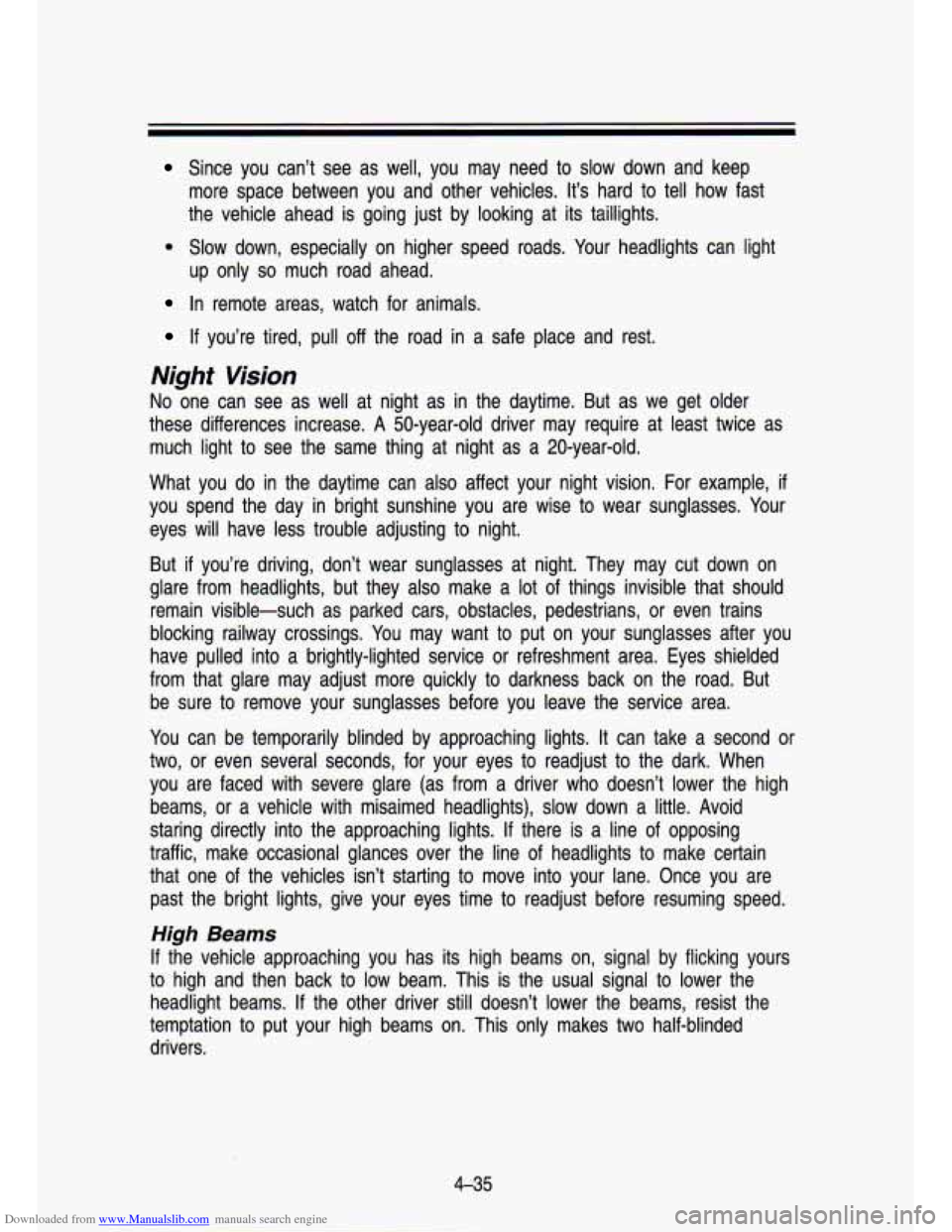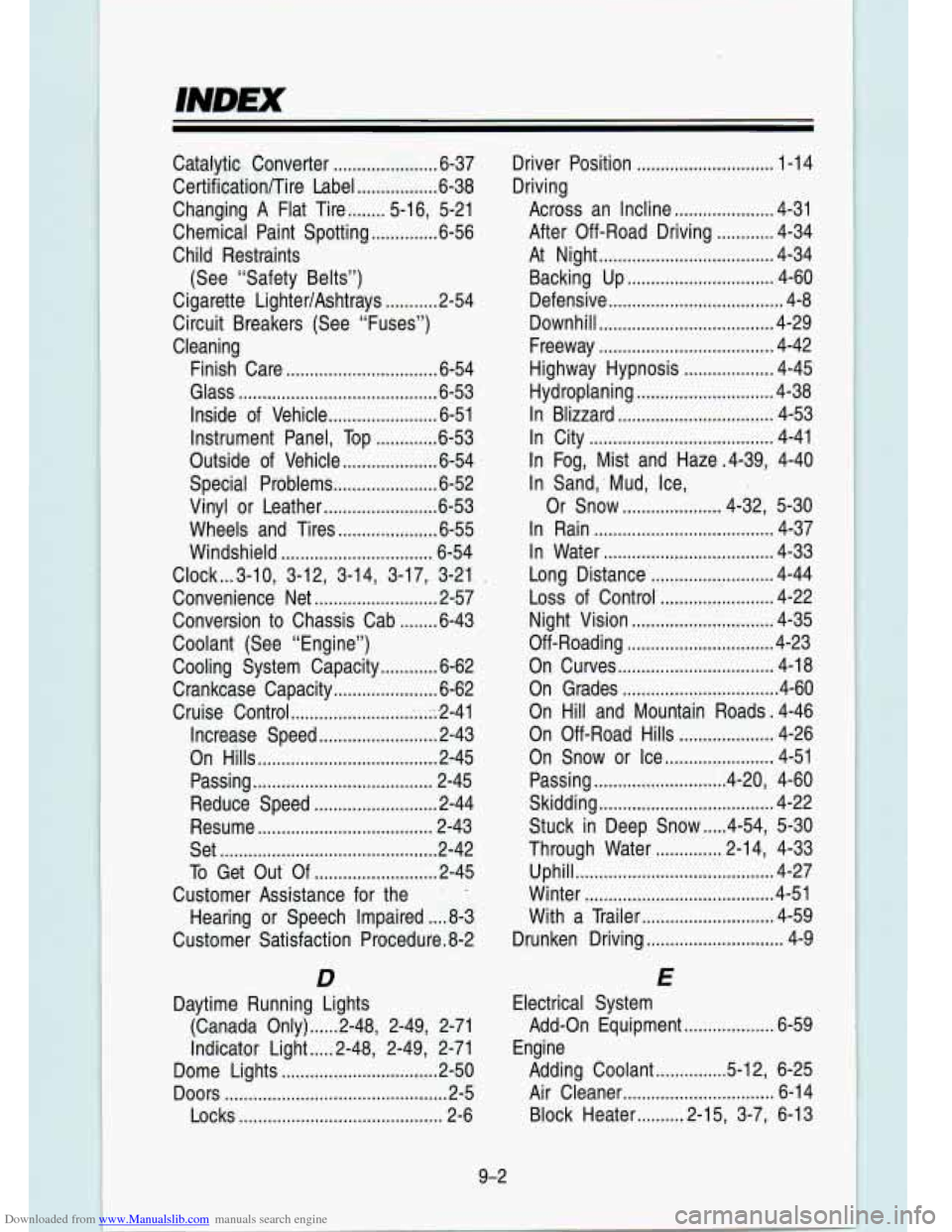1993 CHEVROLET S10 night vision
[x] Cancel search: night visionPage 188 of 356

Downloaded from www.Manualslib.com manuals search engine Your Driving and the Road
After Off-Road Driving
Remove any brush or debris that has collected on the underbodv\
. chassis, or
under the hood. These accumulations can be a fire hazard.
After operation in mud or sand, have the brake linings cleaned\
and checked.
These substances can cause glazing and uneven braking. Check th\
e body
structure, steering, suspension, wheels, tires, and exhaust syste\
m for damage.
Also, check the fuel lines and cooling system for any leakage.\
Your vehicle will require more frequent service due to off-road use.\
Refer to
the Maintenance Schedule for additional information.
Driving at Night
AN450005
Night driving is more dangerous than day driving. One reason is that some
drivers are likely
to be impaired-by alcohol or drugs, with night vision
problems, or by fatigue.
Here are some tips on night driving.
Drive defensively. Remember, this is the most dangerous time.
Don’t drink and drive (See “Drunken Driving” in the Index for more on
this problem.)
Adjust your inside rearview mirror to reduce the glare from headlights
behind you.
4-34
Page 189 of 356

Downloaded from www.Manualslib.com manuals search engine Since you can’t see as well, you may need to slow down and keep
more space between you and other vehicles. It’s hard to tell how fast
the vehicle ahead is going just by looking at its taillights.
@ Slow down, especially on higher speed roads. Your headlights can light
up only
so much road ahead.
In remote areas, watch for animals.
If you’re tired, pull off the road in a safe place and rest.
Night Wsion
No one can see as well at night as in the daytime. But as we get older
these differences increase. A 50-year-old driver may require at \
least twice as
much light to see the same thing at night as a 20-year-old.
What you do in the daytime can also affect your night vision. For \
example,
if
you spend the day in bright sunshine you are wise to wear sunglasses. Your
eyes will have less trouble adjusting to night.
But
if you’re driving, don’t wear sunglasses at night. They may cut down on
glare from headlights, but they also make a lot of things inv\
isible that should remain visible-such as parked cars, obstacles, pedestrians, or even trains
blocking railway crossings. You may want
to put on your sunglasses after you
have pulled into a brightly-lighted service or refreshment area. Eyes shielded
from that glare may adjust more quickly to darkness back on the road. But
be sure
to remove your sunglasses before you leave the service area.
You can be temporarily blinded by approaching lights. It can take a second or
two, or even several seconds, for your eyes to readjust to the dark. When
you are faced with severe glare (as from a driver who doesn’t lower the high
beams, or a vehicle with misaimed headlights), slow down a li\
ttle. Avoid
staring directly into the approaching lights.
If there is a line of opposing
traffic, make occasional glances over the line of headlights to make certain
that one of the vehicles isn’t starting to move into your lane. Once you are
past the bright lights, give your eyes time to readjust before\
resuming speed.
High Beams
If the vehicle approaching you has its high beams on, signal by flicking yours
to high and then back to low beam. This is the usual signal to lower the
headlight beams.
If the other driver still doesn’t lower the beams, resist the
temptation to put your high beams on. This only makes
two half-blinded
drivers.
4-35
Page 190 of 356

Downloaded from www.Manualslib.com manuals search engine Your Driving and the Road
On a freeway, use your high beams only in remote areas where you won’t
impair approaching drivers. In some places, like cities, using high beams is
illegal.
When you follow another vehicle on a freeway or highway, use \
low beams.
True, most vehicles now have day-night mirrors that enable the \
driver to
reduce glare. But outside mirrors are not of this type and high beams from
behind can bother the driver ahead.
A Few More Night Driving Suggestions
Keep your windshield and all the glass on your vehicle clean-i\
nside and out.
Glare at night is made much worse by dirt on the glass. Even the inside of
the glass can build up a film caused by dust. Tobacco smoke \
also makes inside glass surfaces very filmy and can be a vision hazard
if it’s left there.
Dirty glass makes lights dazzle and flash more than clean glas\
s would,
making the pupils of your eyes contract repeatedly. You might even want to
keep a cloth and some glass cleaner in your vehicle
if you need to clean
your glass frequently.
Remember that your headlights light up far less of a roadway when you are
in a turn or curve.
Keep your eyes moving; that way, it’s easier to pick out dimly lighted objects.
Just as your headlights should be checked regularly for proper \
aim,
so should
your eyes be examined regularly. Some drivers suffer from night\
blindness-the inability to see in dim light-and aren’t even aware of
it.
4-36
Page 199 of 356

Downloaded from www.Manualslib.com manuals search engine On the Road
Unless you are the only driver, it is good to share the driving task with
others. Limit turns behind the wheel to about
100 miles (160 km) or two
hours at a sitting. Then, either change drivers or stop for s\
ome refreshment
like coffee, tea or soft drinks and some limbering up. But
do stop and move
around. Eat lightly along the way. Heavier meals tend to make some people
sleepy.
On two-lane highways or undivided multilane highways that
do not have
controlled access, you’ll want to watch for some situations not usually found
on freeways. Examples are: stop signs and signals, shopping cen\
ters with
direct access to the highway, no passing zones and school zones, vehicles
turning left and right
off the road, pedestrians, cyclists, parked vehicles, and
even animals.
Highway Hypnosrs
Is there actually such a condition as “highway hypnosis?” Or \
is it just plain
falling asleep at the wheel? Call it highway hypnosis, lack of awareness, or
whatever.
There is something about an easy stretch of road with the same scenery,
along with the hum of the tires on the road, the drone of the engine, and the
rush of the wind against the vehicle that can make you sleepy. Don’\
t let it
happen to you!
If it does, your vehicle can leave the road in less than a
second, and you could crash and be injured.
What can you
do about highway hypnosis? First, be aware that it can
happen.
Then here are some tips:
Make sure your vehicle is well ventilated, with a comfortably \
cool interior.
Keep your eyes moving. Scan the road ahead and to the sides. \
Check
your rearview mirrors frequently and your instruments from time \
to time.
This can help you avoid a fixed stare.
Wear good sunglasses in bright light. Glare can cause drowsines\
s. But don’t wear sunglasses at night. They will drastically reduce \
your overall
vision at the very time you need all the seeing power you have.
If you get sleepy, pull off the road into a rest, service, or parking area
and take a nap, get some exercise, or both. For safety, treat drowsiness
on the highway as an emergency.
As in any driving situation, keep pace with traffic and allow adequat\
e
following distances.
4-45
Page 348 of 356

Downloaded from www.Manualslib.com manuals search engine INDEX
Catalytic Converter ......... ...... ..._. 6-37
CertificationlTire Label
................. 6-38
Changing A Flat Tire
........ 5-16, 5-21
Chemical Paint Spotting
.............. 6-56
Child Restraints
Cigarette LighterlAshtrays
........... 2-54
Circuit Breakers (See “Fuses”)
Cleaning (See “Safety
Belts”)
Finish Care
................................ 6-54
Glass
.......................................... 6-53
Inside of Vehicle
....................... 6-51
Instrument Panel, Top
............. 6-53
Outside
of Vehicle .................... 6-54
Special Problems
...................... 6-52
Vinyl or Leather
................-...... 6-53
Wheels and Tires
..................... 6-55
Windshield
................................ 6-54
Convenience Net
.......................... 2-57
Conversion
to Chassis Cab ........ 6-43
Coolant (See “Engine”)
Cooling System Capacity
............ 6-62
Crankcase Capacity
...................... 6-62
Cruise Control
................................ 2-41
Increase Speed
......................... 2-43
On Hills
...................................... 2-45
Passing
...................................... 2-45
Reduce Speed
......................... -2-44
Resume
..................................... 2-43
Set
.............................................. 2-42
To Get Out Of .......................... 2-45
Clock
... 3-10, 3-12,
3-14, 3-17, 3-21
Customer Assistance for the Hearing or Speech Impaired
.... 8-3
Customer Satisfaction Procedure.8-2
D
(Canada Only) ...... 2-48, 2-49, 2-71
Indicator Light
..... 2-48, 2-49, 2-71
Dome Lights
................................. 2-50
Doors
............................................... 2-5
Daytime Running Lights
Locks
........................................... 2-6 9-2 Driver Position
............................. 1-14
Driving Across an Incline
..................... 4-31
After Off-Road Driving
............ 4-34
At Night
..................................... 4-34
Backing Up
............................... 4-60
Defensive
..................................... 4-8
Downhill
..................................... 4-29
Freeway
..................................... 4-42
Highway Hypnosis
................... 4-45
Hydroplaning
............................. 4-38
In Blizzard
................................. 4-53
In City
....................................... 4-41
In Fog, Mist and Haze .4-39, 4-40
In Sand,
. Mud, Ice,
Or Snow
..................... 4-32, 5-30
In Rain
...................................... 4-37
In Water .................................... 4-33
Long Distance
.......................... 4-44
Loss of Control
........................ 4-22
Night Vision
.............................. 4-35
Off-Roading
............................... 4-23
On Curves
................................. 4-18
On Grades
................................. 4-60
On Hill and Mountain Roads
. 4-46
On Off-Road Hills
.................... 4-26
On Snow or Ice
....................... 4-51
Passing
............................ 4-20, 4-60
Skidding
..................................... 4-22
Stuck in Deep Snow
..... 4-54, 5-30
Through Water
.............. 2-14, 4-33
Uphill
.......................................... 4-27
Winter
........................................ 4-51
With a Trailer
............................ 4-59
Drunken Driving
............................. 4-9
E
Electrical System
Engine Add-on
Equipment
................... 6-59
Adding Coolant
............... 5-1 2, 6-25
Air Cleaner
................................ 6-14
Block Heater
.......... 2-15, 3-7, 6-13